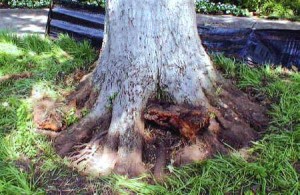
 With the weather getting warmer, lots of people are turning their attention back to their yards and landscaped lawns. There is a lot of work to be done to prepare for the incoming heat. One thing you should inspect is the health of your garden and trees. Spring is a notable time for diseases and infestations, as all the little critters are coming back out to play. Here are five common Decatur tree diseases and how to spot them.
With the weather getting warmer, lots of people are turning their attention back to their yards and landscaped lawns. There is a lot of work to be done to prepare for the incoming heat. One thing you should inspect is the health of your garden and trees. Spring is a notable time for diseases and infestations, as all the little critters are coming back out to play. Here are five common Decatur tree diseases and how to spot them.
1) Root Rot

Root Rot
This is, possibly, the most common problem that Atlanta trees experience. Root rot occurs when the soil a tree’s roots are living in is too wet for too long. This can happen when the soil has poor drainage, when it has been consistently over watered or when a drain spout or air conditioning unit keeps it constantly damp. The first signs of root rot are usually seen in a tree’s branches and leaves. If the leaves are small, pale or shriveled, this may be a sign of root rot. Also, if you notice that the tree’s canopy seems sparser or if you see exposed branches with no new leaves on them, you should start to dig a little further.
2) Seiridium Canker
This is a Decatur tree disease caused by the Seiridium unicorne fungus. It tends to affect trees that are heat stressed or experiencing drought. The first sign of this disease are usually the withering or death of the tree’s leaves, followed by twigs and branches dying off. You can also see a reddish tinge on the bark itself or darkened bark with resin spilling from open cankers.
3) Fire Blight
With fire blight, you tend to see the first symptoms as young twigs and branches dying off. You might notice that these branches have an orange or red tint to them or that they are bent. These branches often have dead leaves or fruit on them, as this tends to affect mostly fruit trees like crabapple trees or pear trees. The disease is most prevalent in early spring and it happens when there is an excess of rainy, hot days.
4) Slime Flux
Also known as Bacterial Westwood, this disease is caused by a bacterial infection. While this disease can occur naturally from outside stressors, it can also be the result of a wounded tree. It manifests itself as a wet spot on a trunk that looks like it is leaking water. This leaking is fermented sap, which is poisonous to new wood; however, it may also be a sign that your tree is at least trying to fight off this infection.
5) Leaf and Twig Gall
If you notice bumps or galls on the leaves of your trees, it is probably that they are infected. This Decatur tree disease is commonly caused by insects or mites. This growth is caused by a reaction between plant hormones and chemicals released by growing and feeding mites or insects. Think of it like the insect sharing a little too much with its meal. While the primary cause might also be a fungus, the culprit is usually an insect. If you notice an abundance of insects along with these galls, you need to seek some help to rid your tree of the infestation.
